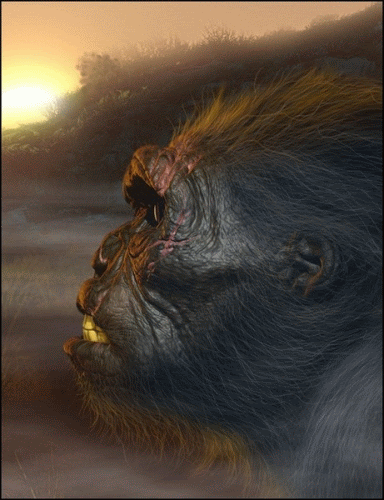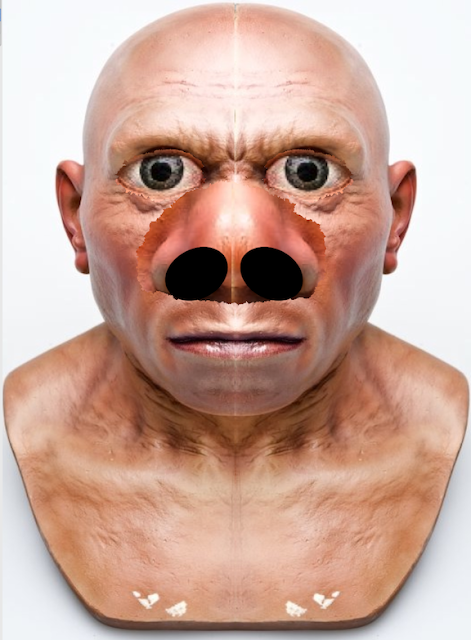Skip to comments.
Genetic Studies of Modern Populations Show Varying Neandertal Ancestry
Popular Archaeology ^
| 3-12-2012
Posted on 03/20/2012 4:55:36 AM PDT by Renfield
The complex world of human genetics research speaks a language unfamiliar to most of us, but it has opened up a new window on our understanding of the dynamics of ancient populations; and few areas of research have been more tantalizing than that surrounding the questions of how modern humans are related to the Neandertals, an ancient species of human whose morphology or physical characteristics disappeared from the human fossil record roughly 30,000 years ago. The most recent studies have provided evidence about when the Neandertal (Homo neandertalensis) and modern human populations (Homo sapiens) first diverged from a common ancestral population. They have also suggested that Neandertals and ancient modern humans interbred, and that some distinct modern populations have more Neandertal ancestry than others.
In a 2010 benchmark study conducted by a consortium of scientists and institutions, researchers compared and analyzed a Neandertal genome constructed from samples taken from the bones of three Neandertal individuals excavated at the Vindija Cave in Croatia. A genome is an organism's complete hereditary information as encoded encoded in DNA. They compared the genome with modern human genomes from a sampling of present-day human groups from different parts of the world. What they found was a number of genetic variants in regions along the genome that both Neandertals and modern humans shared as a result of positive natural selection, "including genes involved in metabolism and in cognitive and skeletal development". [1]
The evidence suggested some additional conclusions. One of them deals with the long-standing debate about when modern humans and Neandertals diverged in the time-line of evolution. Examination of the new data now indicates that the split took place between 270,000 and 440,000 years ago, "a date that is compatible with some interpretations of the paleontological and archaeological record" and a common ancestor that lived within the last 500,000 years. [1]
Equally significant is the answer they found regarding how the Neandertal genome variants ended up in the modern human genome in the first place.
"A challenge in detecting signals of gene flow between Neandertals and modern human ancestors," state the study authors in the report, "is that the two groups share common ancestors within the last 500,000 years, which is no deeper than the nuclear DNA sequence variation within present-day humans. Thus, even if no gene flow occurred, in many segments of the genome, Neandertals are expected to be more closely related to some present-day humans than they are to each other. However, if Neandertals are, on average across many independent regions of the genome, more closely related to present-day humans in certain parts of the world than in others, this would strongly suggest that Neandertals exchanged parts of their genome with the ancestors of these groups." [1]
In other words, if there are differences in the degree to which different geographically dispersed present-day population groups show Neandertal ancestry, this would suggest that Neandertals and ancient modern human ancestors interbred.
*We performed this test using eight present-day humans: two European Americans (CEU), two East Asians (ASN), and four West Africans (YRI) We find that the Neandertals are equally close to Europeans and East Asians....... However, the Neandertals are significantly closer to non-Africans than to Africans." [1]
The researchers' best explanation for these findings is that the Neandertals exchanged genes with the ancestors of non-Africans. Eurasian Neandertals interbred with ancient modern humans. But, the study authors continue, "the actual amount of interbreeding between Neandertals and modern humans may have been very limited, given that it contributed only 1 to 4% of the genome of present-day non-Africans". [1]
What is more, they were able to determine the relative time in which the mixing began:
A striking observation is that Neandertals are as closely related to a Chinese and Papuan individual as to a French individual, even though morphologically recognizable Neandertals exist only in the fossil record of Europe and western Asia. Thus, the gene flow between Neandertals and modern humans that we detect most likely occurred before the divergence of Europeans, East Asians, and Papuans. This may be explained by mixing of early modern humans ancestral to present-day non-Africans with Neandertals in the Middle East before their expansion into Eurasia. Such a scenario is compatible with the archaeological record, which shows that modern humans appeared in the Middle East before 100,000 years ago whereas the Neandertals existed in the same region after this time, probably until 50,000 years ago. [1]
Any canoodling, then, may have actually started before the two species encountered each other in what is now present-day Europe or West Asia.
The picture becomes more complicated with later studies, which have shown some interesting new details. John Hawks, Associate Professor of Anthropology at the University of Wisconsin—Madison, reports the results of a study of the comparison of East Asian region samples (Japanese, Han Chinese in Beijing, and Han Chinese originating in South China) with European region samples (Tuscans, British, Finn, CEU, and Spanish) taken from the 1000 Genomes Project in his weblog entitled The Malapa Soft Tissue Project. Here he concludes that "the Europeans average a bit more Neandertal than Asians", suggesting that "Europeans may have mixed with Neandertals as they moved into Europe, constituting a second process of population mixture beyond that shared by European and Asian ancestors". [2] More interesting still were the differences detected among the samples within each of the two regions. Within the East Asian region, the North China population was found to have more Neandertal indicators than the South China, and within the European region, the southern populations more than the northern, with the Tuscans having "the highest level of Neandertal similarity of any of the 1000 Genomes Project samples". [2] Hawks relates the results of research on African populations, as well, which also show variability. He points to the Yoruba people, a West African population, having significantly more Neandertal genome similarity than the Luhya, an East African population. "We now know from examination of genetic variation within Africa today," states Hawks about the possible implications, "that some of today's diversity can be traced to ancient population structure in Middle Pleistocene African populations. For example, Neandertals could be more closely related to some African populations than others today because Neandertals actually exchanged genes with some ancient African populations. Or Neandertals might have sprung from one African population among many who lived 250,000 years ago..........As we combine the archaic genome data with our growing picture of diverse lineages in Africa today, we may discover ancient populations that are not apparent archaeologically. Again, genetics is giving us a totally new picture of the diversity and population dynamics of ancient people." [2]
Genome research continues to provide new findings through an expanding source of shared data, affording new details. Looking forward, Hawks asks the next question: "Which Neandertal-derived variants are shared between regions, and which are unique to one region?......Now, we have sequences capable of telling us much more." [2]
[1] Green, Richard E., et.al., A Draft Sequence of the Neandertal Genome, Science 7 May 2010, Vol. 328 no. 5979 pp. 710-722 DOI: 10.1126/science.1188021.
[2] John Hawks, The Malapa Soft Tissue Project, Weblog at http://johnhawks.net/malapa.
TOPICS: History; Science
KEYWORDS: gagdadbob; genetics; godsgravesglyphs; helixmakemineadouble; neandertal; neandertals; neanderthal; neanderthals; onecosmosblog; paleoanthropology
Navigation: use the links below to view more comments.
first previous 1-20, 21-40, 41-60, 61-80, 81-85 next last
To: Mariner
"Maybe someday science will be able to tell us if this has anything to do with the differences in social developments...farming...cities...armies etc. All these things began to emerge as Neanderthal was disappearingSOMETHING DID. :)
bttt
21
posted on
03/20/2012 6:35:59 AM PDT
by
Matchett-PI
("Andrew loved the battle and he knew the stakes." ~ Mark Levin 3/2/12)
To: Mariner
22
posted on
03/20/2012 6:49:30 AM PDT
by
blam
To: The Sons of Liberty
That's going to be argued by many here to be a KOINKYDINK.
On the other hand it's a very well made observation.
The cold hard facts are the Neanderthals were working on becoming MODERN HUMANS as in Sapiens Sapiens more than 300,000 years ago. The current crowd who imagine themselves to be MODERN HUMANS started only 180,000 years ago.
That's a full Glacial Cycle ~ the kind of experience that imbeds itself in the genes. The more recent ability to outbreed our range does not really make us advanced ~ just more like bunny rabbits.
23
posted on
03/20/2012 7:13:48 AM PDT
by
muawiyah
To: Mariner
The article suggests there are simply LESS Neanderthal genes in blacks than in whites and East Asians.
However, to be PC the writers didn't say any blacks at all had any Neanderthal genes ~ but you are clever to have noticed the difference. Remember, if the writer had said "blacks have Neanderthal genes" the NAACP and their running dog lackeys would be bouncing off the walls screaming "He used the N-word".
24
posted on
03/20/2012 7:16:47 AM PDT
by
muawiyah
To: Citizen Tom Paine
Ah, not so. Neanderthals brains might have been larger, but that does NOT neccesarily mean they were smarter. People with large brains now may be either smart or stupid. Size of brain does not seem to equate with intelligence. The extra brain capacity of Homo Neanderthalis was mostly in the rear lobes i.e. those bits concerned with memory, not reasoning.
And objectively, if Neanderthals were smarter than modern Homo Sapiens, then why did they die out? Surely if they were smarter, they would have been able to outcompete us?
25
posted on
03/20/2012 7:24:31 AM PDT
by
Vanders9
To: Marylander; Rich21IE
BTW, this is all new stuff. Recent advances in obtaining good DNA from old bones are making this possible.
26
posted on
03/20/2012 7:27:09 AM PDT
by
muawiyah
To: Renfield
One very busy neanderthal guy fertilized millions of homo sapien women.
27
posted on
03/20/2012 7:27:09 AM PDT
by
bunkerhill7
(Horny neanderthals?? Who knew?)
To: Vanders9
Having more and better memory is always good.
However, brain size does matter even today. Let's say you are born without a brain ~ your life expectancy is going to be pretty short. Or, you could be like Joe Biden and have brain surgery 3 times, and you'll pay for even the slightest disturbances ~ and we can see that almost every day recently. Guy is deteriorating before our eyes.
The point of this article is that Neanderthals did not die out ~ they were absorbed into our current genome.
28
posted on
03/20/2012 7:31:03 AM PDT
by
muawiyah
To: blam
we are neanderthals.
This stuff has been posted recently.
Once again, this is what Neanderthals looked like:

Image courtesy of www.themandus.org
There has never been any mixing of human stock and THAT and the people making such claims are suffering from a breakdown in basic logic.
There is terribly little genetic variation in the human race compared to all but one or two other mammals and that is due to some fairly recent genetic bottleneck which reduced the human population to a very small number of individuals, possibly less than fifty or a hundred.
If there ever had been any human/Neanderthal crossbreeding, it would have happened either before or after the bottleneck. I think even the logically impaired/challenged would have to agree to that...
If human/Neanderthal crossbreeding happened before the bottleneck, you'd not read these claims of whites and East Asians having Neanderthal genes but Africans not having it; we'd all have them. If any human group had mixed with Neanderthals AFTER that bottleneck, the variation between that group and all others (humans) would be gigantic.
The only conclusion which is tenable is that there has never been any mixing of humans and Neanderthals, and that any similar genes anybody finds are just artifacts of same or similar low-level components being used by an original designer or designers.
There is zero possibility of humans and apes interbreeding. Joseph Stalin's scientists tried to create a race of super workers by crossing apes and humans in the 1930s and none of the subjects even survived. Even the idiot commies recognized the project as a failure.
To: PapaBear3625
In other words, there are distinct genetic differences between African and non-African populations, and these differences include genes that affect IQ. Maybe you could tell us why the greatest poet ever to write in any IndoEuropean language (Pushkin) was a man of color or how his great grandfather, a pure African kid given to Tsar Peter by the sultan of Turkey became a major minister in Tsar Peter's court, or how Scott Joplin became the greatest American composer of piano music, or how.....
Science and bullshit don't really mix well.
To: Renfield
You might want to look at post 29 as well. The Neanderthal was a bipedal and 100% carniverous ice-age ape with an 8” fur coat and huge eyes for nocturnal hunting. The sum total of genetic content from Neanderthals in modern humans is zero.
To: Einherjar
"Genesis 19:30" A strange and disturbing reading.
32
posted on
03/20/2012 7:56:52 AM PDT
by
FroggyTheGremlim
(Conservative patriots, Rise up!)
To: varmintman
"The sum total of genetic content from Neanderthals in modern humans is zero."
Oh yeah?
33
posted on
03/20/2012 8:00:19 AM PDT
by
FroggyTheGremlim
(Conservative patriots, Rise up!)
To: muawiyah
Memory is great, but it is reasoning that sets us apart from the beasts. Sure brain size must be of some importance, but the link to intelligence is not a straightforward progression. As to Neanderthals being absorbed into our genome - well yes, it's a logical possibility, but saying it did happen is pure supposition on their part. 1% t 3% is hardly statistically significant, especially on a sample of exactly 8 people, two of whom didnt register anything.
34
posted on
03/20/2012 9:15:37 AM PDT
by
Vanders9
To: varmintman
Maybe you could tell us why the greatest poet ever to write in any IndoEuropean language (Pushkin) was a man of color There is a thing called a Distribution Curve. In any subgroup there are people at the right end of the curve, people in the middle, and people at the left end. The highest-IQ people of subgroup A are going to be smarter than the average person in subgroup B, even if the median IQ of subgroup B is more than the median for A.
35
posted on
03/20/2012 9:37:22 AM PDT
by
PapaBear3625
(In a time of universal deceit, telling the truth is a revolutionary act. - George Orwell)
To: The Sons of Liberty
May be coincidence, but those with Neanderthal heritage are advanced technological societies. The common assumption is that Neanderthals were stupid. Stupid people don't survive in cold climates. Mistakes are more likely to result in your death.
36
posted on
03/20/2012 9:41:05 AM PDT
by
PapaBear3625
(In a time of universal deceit, telling the truth is a revolutionary act. - George Orwell)
To: Marylander
I believe they were talking about mitochondrial DNA, and found no evidence of interbreeding, Studies of other parts of the DNA show substantial evidence of interbreeding. I think mitochondrial has some unique properties with respect to ancestry that should be considered when analyzing ancestral interbreeding. Mitochondrial DNA is passed directly from mother to child, with no contribution from the father's DNA. The DNA in the nucleus is half from the father, half from the mother. If no Neanderthal mitochondrial DNA is found, that indicates that any inter-racial mating involved Neanderthal men mating CroMag women (or at least, mating which resulted in surviving progeny).
37
posted on
03/20/2012 9:46:00 AM PDT
by
PapaBear3625
(In a time of universal deceit, telling the truth is a revolutionary act. - George Orwell)
To: varmintman
Once again, this is what Neanderthals looked like: So says Danny Vendramini, a writer with whose credentials are hard for me to find after a a bit of searching. A bio pages says "Australian born, Danny Vendramini had successful careers as a theater and film director and scriptwriter before turning to evolutionary biology".
Reconstructions by people with actual science backgrounds have Neanderthals looking not too different from us. Give one a shave, shower, and modern clothes and you would probably walk pass him on the street without thinking him that unusual.
38
posted on
03/20/2012 10:01:49 AM PDT
by
PapaBear3625
(In a time of universal deceit, telling the truth is a revolutionary act. - George Orwell)
To: PapaBear3625
Vendramini's reconstructions are consistent with the DNA evidence: none of the others are.
The claim that they had the usual ice-age fur coats is consistent with the total lack of Neanderthal needles; creatures with fur coats don't need clothing or needles.
Vendramini's depiction of the huge nocturnal predator eyes is consistent with the huge Neanderthal eye sockets and the same is true of the Neanderthal nasal area. Attempts to draw a more human-like Neanderthal with eyes and noses the sizes they'd have to be look outlandish:

The basic reality is that the images you're used to seeing are artefacts of fiction.
To: PapaBear3625
Stupid people don't survive in cold climates. If you have an 8" fur coat it's easier...
Navigation: use the links below to view more comments.
first previous 1-20, 21-40, 41-60, 61-80, 81-85 next last
Disclaimer:
Opinions posted on Free Republic are those of the individual
posters and do not necessarily represent the opinion of Free Republic or its
management. All materials posted herein are protected by copyright law and the
exemption for fair use of copyrighted works.
FreeRepublic.com is powered by software copyright 2000-2008 John Robinson

